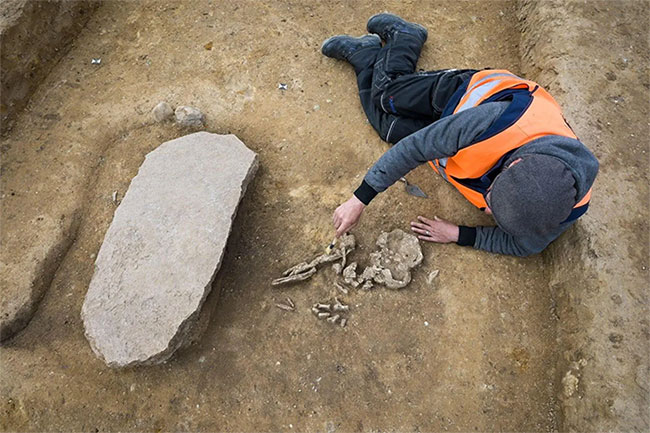German archaeologists accidentally found an area they call a “zombie grave” during inspections to prepare for work to expand the power grid.
According to Heritage Daily, the “zombie tomb” was built 4,200 years ago during the Bronze Age , containing the remains of a man who was about 40-60 years old when he died.
The discovery came by chance when the Saxony-Anhalt State Office for Monuments Conservation and Archeology (Germany) was tasked with inspecting the 150km strip of land where the new power grid is expected to pass through the state.
It is an area that is likely to contain many archaeological relics because it was settled by humans over many periods of time.
 An archaeologist is excavating a “zombie grave” in Germany – (Photo: Saxony-Anhalt State Office for Monuments Conservation and Archeology).
An archaeologist is excavating a “zombie grave” in Germany – (Photo: Saxony-Anhalt State Office for Monuments Conservation and Archeology).
The reason researchers call it a “zombie grave” is because the way people are buried in the grave is very unusual.
A large block of rock was placed over half of the man’s body, which according to researchers, was likely placed to prevent the individual from rising as a zombie.
According to excavation project director Susanne Friederich, since the Stone Age, residents in this area have tended to fear people who have the ability to rise from the graves.
The image of a reanimated, walking corpse has been depicted in many different cultures, including ancient Celtic and Norse mythology, legends, and folktales throughout Europe.
Those images are very similar to zombies in the way that today’s movies depict.
Thus, in the Middle Ages, people believed to be “zombies” were often victims of suicide, witches, corpses possessed by evil spirits, or victims of vampire attacks.
For this grave, the form of burial is associated with the Bell Beaker culture , a Bronze Age people who emerged around 2800 BC and dispersed to most of Western Europe and some coastal areas in the West. North Africa.





